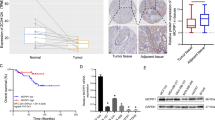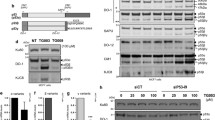Abstract
Purpose
Splicing factor poly(rC)-binding protein 1 (PCBP1) is a novel tumor suppressor that is downregulated in several cancers thereby regulating tumor formation and metastasis. However, the involvement of PCBP1 in apoptosis of cancer cells and the molecular mechanism remains elusive. On this basis, we sought to investigate the role of splicing factor PCBP1 in the apoptosis in human cervical cancer cells.
Methods
To investigate PCBP1 functions in vitro, we overexpressed PCBP1 in human cervical cancer cells. A series of cytological function assays were employed to study to the role of PCBP1 in cell proliferation, cell cycle arrest and apoptosis.
Results
Overexpression of PCBP1 was found to greatly repress proliferation of HeLa cells in a time-dependent manner. It also induced a significant increase in G2/M phase arrest and apoptosis. Furthermore, overexpressed PCBP1 favored the production of long isoforms of p73, thereby inducing upregulated ratio of Bax/Bcl-2, the release of cytochrome c and the expression of caspase-3.
Conclusion
Our results revealed that PCBP1 played a vital role in p73 splicing, cycle arrest and apoptosis induction in human cervical carcinoma cells. Targeting PCBP1 may be a potential therapeutic strategy for cervical cancer therapy.






Similar content being viewed by others
Data availability
The data presented in this study are available in the article.
Abbreviations
- PCBP1:
-
Poly(rC)-binding protein 1
- DNp73:
-
N-terminally truncated p73
- TAp73:
-
Transactivating p73
- EMT:
-
Epithelial-mesenchymal transition
- CD44:
-
Cluster differentiation-44
- Bax:
-
Bcl-2-Associated X
- Bcl-2:
-
B-cell CLL/lymphoma 2
References
Aasheim HC et al (1994) Tissue specific expression and cDNA structure of a human transcript encoding a nucleic acid binding [oligo(dC)] protein related to the pre-mRNA binding protein K. Nucleic Acids Res 22(6):959–964
Baralle D, Buratti E (2017) RNA splicing in human disease and in the clinic. Clin Sci (Lond) 131(5):355–368
Barboro P, Ferrari N, Balbi C (2014) Emerging roles of heterogeneous nuclear ribonucleoprotein K (hnRNP K) in cancer progression. Cancer Lett 352(2):152–159
Bray F et al (2018) Global cancer statistics 2018: GLOBOCAN estimates of incidence and mortality worldwide for 36 cancers in 185 countries. Cancer J Clin 68(6):394–424
Chaudhury A, Chander P, Howe PH (2010) Heterogeneous nuclear ribonucleoproteins (hnRNPs) in cellular processes: focus on hnRNP E1’s multifunctional regulatory roles. RNA 16(8):1449–1462
Chkheidze AN, Liebhaber SA (2003) A novel set of nuclear localization signals determine distributions of the alphaCP RNA-binding proteins. Mol Cell Biol 23(23):8405–8415
Choi HS et al (2007) Novel function of the poly (C)-binding protein αCP3 as a transcriptional repressor of the mu opioid receptor gene. FASEB J 21(14):3963–3973
Dejgaard K, Leffers H (1996) Characterisation of the nucleic-acid-binding activity of KH domains. Different properties of different domains. Eur J Biochem 241(2):425–431
Di CX et al (2015) Diallyl disulfide attenuated carbon ion irradiation-induced apoptosis in mouse testis through changing the ratio of TAp73/DeltaNp73 via mitochondrial pathway. Sci Rep 5:16020
Di CX et al (2019) Function, clinical application, and strategies of Pre-mRNA splicing in cancer. Cell Death Differ 26(7):1181–1194
Gomez LC et al (2018) TP73 DNA methylation and upregulation of Delta Np73 are associated with an adverse prognosis in breast cancer. J Clin Pathol 71(1):52–58
Guo JH, Jia R (2019) Splicing factor poly(rC)-binding protein 1 is a novel and distinctive tumor suppressor. J Cell Physiol 234(1):33–41
Holtkamp N et al (2007) MMP-13, p53 in the progression of malignant peripheral nerve sheath tumors. Neoplasia 9(8):671–677
Ishii T et al (2018a) Specific binding of PCBP1 to heavily oxidized RNA to induce cell death. Proc Natl Acad Sci USA 115(26):6715–6720
Ishii T et al (2018b) Specific binding of PCBP1 to heavily oxidized RNA to induce cell death. Proc Natl Acad Sci USA 115(26):6715–6720
Ji FJ et al (2017) Expression of both poly r(C) binding protein 1 (PCBP1) and miRNA-3978 is suppressed in peritoneal gastric cancer metastasis. Sci Rep 7(1):15488
Jiang P et al (2017) Fyn/heterogeneous nuclear ribonucleoprotein E1 signaling regulates pancreatic cancer metastasis by affecting the alternative splicing of integrin beta1. Int J Oncol 51(1):169–183
Jin P et al (2020) Prognostic alternative mRNA splicing signatures and associated splicing factors in acute myeloid leukemia. Neoplasia 22(9):447–457
Kwak HB, Song W, Lawler JM (2006) Exercise training attenuates age-induced elevation in Bax/Bcl-2 ratio, apoptosis, and remodeling in the rat heart. FASEB J 20(6):791–793
Liu SS et al (2006) Enhancement of the radiosensitivity of cervical cancer cells by overexpressing p73alpha. Mol Cancer Ther 5(5):1209–1215
Liu Y et al (2015) Expression of poly(C)-binding protein 1 (PCBP1) in NSCLC as a negative regulator of EMT and its clinical value. Int J Clin Exp Pathol 8(6):7165–7172
Lu J, Gao FH (2016) Role and molecular mechanism of heterogeneous nuclear ribonucleoprotein K in tumor development and progression. Biomed Rep 4(6):657–663
Lu X et al (2019) Immune signature-based subtypes of cervical squamous cell carcinoma tightly associated with human papillomavirus type 16 expression, molecular features, and clinical outcome. Neoplasia 21(6):591–601
Lucena-Araujo AR et al (2015) High DeltaNp73/TAp73 ratio is associated with poor prognosis in acute promyelocytic leukemia. Blood 126(20):2302–2306
Lunghi P et al (2009) The p53 family protein p73 provides new insights into cancer chemosensitivity and targeting. Clin Cancer Res 15(21):6495–6502
Melino G, De Laurenzi V, Vousden KH (2002) p73: Friend or foe in tumorigenesis. Nat Rev Cancer 2(8):605–615
Muller M et al (2005) TAp73/Delta Np73 influences apoptotic response, chemosensitivity and prognosis in hepatocellular carcinoma. Cell Death Differ 12(12):1564–1577
Nandal A et al (2011) Activation of the HIF prolyl hydroxylase by the iron chaperones PCBP1 and PCBP2. Cell Metab 14(5):647–657
Pillai MR et al (2003) Expression of folate receptors and heterogeneous nuclear ribonucleoprotein E1 in women with human papillomavirus mediated transformation of cervical tissue to cancer. J Clin Pathol 56(8):569–574
Prieto-Nieto MI et al (2019) Delta Np73 status in peritoneal and ovarian dissemination of appendicular adenocarcinoids (goblet cells). Clin Transl Oncol 21(10):1432–1439
Raisova M et al (2001) The Bax/Bcl-2 ratio determines the susceptibility of human melanoma cells to CD95/Fas-mediated apoptosis. J Invest Dermatol 117(2):333–340
Rodriguez N et al (2018) Clinical implications of the deregulated TP73 isoforms expression in cancer. Clin Transl Oncol 20(7):827–836
Shafabakhsh R et al (2019) Melatonin: a new inhibitor agent for cervical cancer treatment. J Cell Physiol 234(12):21670–21682
Shi HS et al (2018) PCBP1 depletion promotes tumorigenesis through attenuation of p27(Kip1) mRNA stability and translation. J Exp Clin Cancer Res 37:18
Silipo M, Gautrey H, Tyson-Capper A (2015) Deregulation of splicing factors and breast cancer development. J Mol Cell Biol 7(5):388–401
Tomasini R et al (2008) TAp73 knockout shows genomic instability with infertility and tumor suppressor functions. Genes Dev 22(19):2677–2691
Wang H et al (2010) PCBP1 suppresses the translation of metastasis-associated PRL-3 phosphatase. Cancer Cell 18(1):52–62
Zaika AI et al (2002) Delta Np73, a dominant-negative inhibitor of wild-type p53 and TAp73, is up-regulated in human tumors. J Exp Med 196(6):765–780
Zhang T et al (2010) PCBP-1 regulates alternative splicing of the CD44 gene and inhibits invasion in human hepatoma cell line HepG2 cells. Mol Cancer 9:72
Zhang W et al (2016) Poly C binding protein 1 represses autophagy through downregulation of LC3B to promote tumor cell apoptosis in starvation. Int J Biochem Cell Biol 73:127–136
Zhang Q et al (2019) Inhibition of SF3b1 by pladienolide B evokes cycle arrest, apoptosis induction and p73 splicing in human cervical carcinoma cells. Artif Cells Nanomed Biotechnol 47(1):1273–1280
Zhou M, Tong X (2015) Downregulated Poly-C binding protein-1 is a novel predictor associated with poor prognosis in Acute Myeloid Leukemia. Diagn Pathol 10:147–147
Funding
This work was supported by grants of the national Key R&D project of the Chinese Ministry of Science and Technology (2018YFE0205100), the Key Program of the National Natural Science Foundation of China (U1632270), the National Natural Science Foundation of China (11675234, 11875061), and the Natural Science Foundation of Gansu (17JR5RA310).
Author information
Authors and Affiliations
Contributions
YH Chen, ZH Dou, CX Di and HZ Hong and Q Li conceived the manuscript. YH Chen, CX Di, ZH Dou and XH Chen consulted the literature and wrote the initial draft of the manuscript. DP Zhao, TJ Che, W Su, T Qu, TT Zhang, CP Xu and HW Lei participated in writing the manuscript. All authors reviewed the manuscript.
Corresponding authors
Ethics declarations
Competing interests
The authors have no relevant financial or non-financial interests to disclose.
Additional information
Publisher's Note
Springer Nature remains neutral with regard to jurisdictional claims in published maps and institutional affiliations.
Supplementary Information
Below is the link to the electronic supplementary material.
Rights and permissions
Springer Nature or its licensor holds exclusive rights to this article under a publishing agreement with the author(s) or other rightsholder(s); author self-archiving of the accepted manuscript version of this article is solely governed by the terms of such publishing agreement and applicable law.
About this article
Cite this article
Chen, Y., Dou, Z., Chen, X. et al. Overexpression of splicing factor poly(rC)-binding protein 1 elicits cycle arrest, apoptosis induction, and p73 splicing in human cervical carcinoma cells. J Cancer Res Clin Oncol 148, 3475–3484 (2022). https://doi.org/10.1007/s00432-022-04170-3
Received:
Accepted:
Published:
Issue Date:
DOI: https://doi.org/10.1007/s00432-022-04170-3




